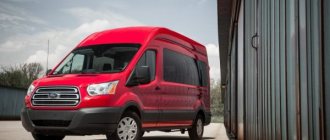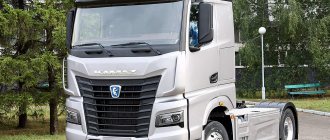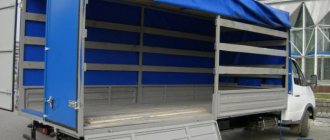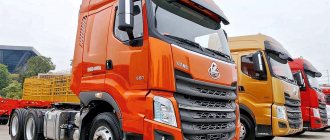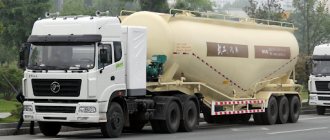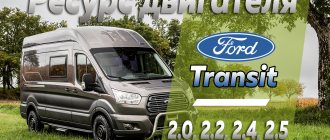Rate this post
The new long-haul tractor Ford Trucks F-MAX, after its presentation in Hannover, appeared before the Russian buyer. The manufacturer intends to squeeze out venerable competitors who have held leadership positions for a long time. This truck won the prestigious Truck of the Year award in 2022. The car is aimed at long-haul freight transportation, where its predecessor, the Ford 1848T, was frankly weak. The new F-MAX is devoid of virtually all the shortcomings that made the Ford 1848T lose competition in the market - first of all, a narrow cabin that was not particularly comfortable. Now Ford Trucks F-MAX is focused on driver comfort, safety, and fuel efficiency. In this article we will tell you what engine and what gearbox a new tractor is equipped with.
Ford Trucks F-MAX engine
Under the Ford Trucks F-MAX cab there is a diesel power unit with a displacement of 12,740 cubic meters. see. It was also installed on the previous family of trucks. Assembled in Turkey and is the most compact in its class. Its rated power is 480 horsepower, but the F-MAX is equipped with a diesel engine with 500 horsepower and 2500 Nm of torque. The speed range has been expanded - 1000-1200 rpm. The engine is based on a 9-liter diesel power unit, which was designed back in 2015. Gradually, engineers at the Ford plant in Turkey increased its displacement and brought it to compliance with modern environmental classes.
The in-house developed Ecotorq engine (FHT5) is Euro 5 compliant and features many modern innovations. Special technologies ensure an optimal balance between engine performance and efficiency: this includes a variable geometry turbocharger and an Ecotorq Engine Brake with a power of up to 400 kW. In terms of architecture, everything is as usual - an in-line “six” with four valves per cylinder, “wet” liners and a camshaft in the cylinder head. The compactness of the internal combustion engine and the structural rigidity of the block are ensured by precisely this arrangement - an upper camshaft and a rear input shaft. The cooling system contains a filter with a corrosion inhibitor, which improves operating conditions and extends the service life of the antifreeze.
As expected by modern standards, the Ecotorq engine is equipped with a catalytic reduction system (SCR). To start the engine, there is a service remote control and an option to temporarily increase idle speed. Thus, the engine is similar in many characteristics to the engines that are equipped with competitive trucks, but compared to them, the Ecotorq (FHT5) is distinguished by the presence of a variable geometry turbocharger. The main competitors decided to abandon this design solution.
Fourth generation (1961-1966)
As can be seen from cars of previous generations, when creating F-series pickups, Ford followed the path of gradual evolutionary development. This worked successfully until in 1960, with the release of the fourth generation pickup trucks, Ford decided to experiment. Along with the classic "Flareside" cargo area, they offered a "Styleside" cargo compartment integrated with the cab, thereby creating a new integrated body. This decision was to Ford's advantage, since during its production it was possible to significantly save on tooling, stamping, welding and painting. Although such a body was called a “unibody”, in fact it was not load-bearing, the cars were still based on a strong steel frame. Nevertheless, buyers were wary of the new product, and such cars were not in great demand, as a result, four years later they were discontinued.
1966 Ford F-100 and Twin-I-Beam suspension
However, these were not all revolutionary changes. In 1964, all light pickup trucks switched to a new, more rigid frame. It turned out to be so successful that it was used on the F-series until the end of the 70s. In addition, on rear-wheel drive versions, instead of the outdated leaf springs, an independent suspension with swing axle shafts and coil springs was used at the front. This suspension, under the marketing designation “Twin-Beam,” was produced right up to 1996. Another significant innovation was the introduction of a two-row, four-door cab on the 1965 Ford F-250 and F-350. The engine line traditionally consisted of six and eight-cylinder units. The most powerful of them appeared at the end of the conveyor cycle in 1965, and had a volume of 5.8 liters and a power of 208 hp.
Tractor gearbox
Paired with a 13-liter diesel engine is a 12-speed robotic transmission. This is a ZF Traxon robot that gives the driver the choice between automated and manual control. There are three operating modes:
- standard.
- dynamic.
- "swing".
The gearbox gear ratio range is 16.69 – 1.00, and the final drive gear ratio (hypoid) is 2.64. The name ZF Traxon is purely marketing; the full name of the 12-speed robot is ZF 12 TX 2620 . Index 2620 indicates the maximum permissible torque that the robot is able to “digest.” Let us remind you that the same transmission was equipped with a domestic tractor in mass production - KAMAZ-54901.
Many truckers are wondering why the manufacturer abandoned ZF AsTronic robots? The box was considered reliable and durable, and generally did not cause significant problems. The main reason is the inconsistency with modern trends and incompatibility with powerful diesel power units. The disadvantage of the ZF AsTronic box is that it did not support the “swing” mode, and there was also no special “coasting” mode. The new Ford Trucks F-MAX has it all. Ford clearly intends to assemble the tractor in Russia, and the gearbox is planned to be assembled at the expense of the production facilities of the KAMA enterprise.
About the manufacturer
Our carriers are already familiar with heavy Ford Trucks - they appeared in Russia in 2007, initially in the form of the H298 model, and occupied a transitional niche in our market between domestic cars and expensive foreign cars made in Europe.
All Ford Trucks models are manufactured in Turkey by Ford Otosan. The main enterprise is located in the city of Eskisehir, covering an area of 1.1 million square meters. m. At the same time, the area of its indoor premises is 118.3 thousand square meters. m. In the heavy truck assembly shop itself, five conveyor lines are installed on which up to 24 different models can be assembled.
With a standard capacity of 15 thousand trucks per year, the company assembles about 8 thousand vehicles per year. In addition to the assembly shop, there is also a stamping, welding, and painting production facility with a surface preparation shop for painting, i.e. cataphoretic priming, as well as a plastic painting workshop.
In addition, the Turkish company Ford Trucks Eskisehir produces its own Ecotorq diesel engines (60% - 9-liter, 40% - 13-liter), as well as Puma / Panther engines and rear drive axles for light trucks of the Ford Transit line.
In addition to purely Turkish Ford F-Max trucks, those that are assembled at the Avtotor car assembly plant in the city of Kaliningrad are also sold on the Russian market.
The Ford F-Max was developed from scratch by Ford's own Otosan research center, located in the suburbs of Istanbul. Initially, a course was set for complete independence in the development of the model, starting from the chassis and engine and ending with the cabin - it was decided to do everything “our own”. In total, the development of the Ford F-Max - from drawings to launch into mass production - took five years.
Turkish trucks are not sold in Western European countries. But these cars are present in all former socialist countries, as well as in Greece - in 19 countries in Europe, plus another 8 African and 10 Asian countries. And with the Ford F-Max model, the Turkish Ford Otosan, one might say, has come close to the European brands.
Chassis, suspension, systems
The drive axle is a unit developed by Ford Trucks. The front suspension uses variable-section single-leaf springs along with anti-roll bars. The permissible load of the drive axle is 11.5 tons. The tractor received an uncharacteristic “European” base – 3600 mm. Hence, on the frame there are two compact tanks of only 600 and 450 liters. Two batteries are arranged vertically - one battery on top of the other, organically and conveniently for maintenance.
The suspension is comfortable and does not rattle; the cabin remains quiet even at high speed. Separately, it is worth mentioning the excellent handling of the truck. While driving, you get the impression that this is not a multi-ton tractor, but a small commercial van. The driving process is facilitated by auxiliary systems and assistants, including cruise control, an emergency braking system, and a driver warning system for leaving your lane.
Seventh generation (1980-1986)
1981 Ford F-150
The seventh generation featured a fairly major update. In appearance, the pickup truck has become even more “square”. The front facade was decorated with a large-mesh radiator grille and rectangular headlights. Since 1982, the large Ford inscription left the edge of the hood, and was replaced by one, which was located in the center of the radiator grille. But the main thing was still hidden under the shell of the body.
For the first time since 1961, the Ford F moved to a new platform. The frame was strengthened, and the Twin-Beam independent suspension was added to all-wheel drive versions. By the early 1980s, there was still a heavy hangover from the gasoline crisis, so Ford engineers had to seriously work on the fuel efficiency of their cars. The outdated M-series engine was replaced by small-displacement Windsor series engines of 4.2 and 5.8 liters. Updated manual and automatic three-speed transmissions also contributed to the reduction in fuel consumption. True, they were offered only as an option; three-speed automatic and manual transmissions were still listed as basic. In addition, engines with electronic fuel injection appeared on pickup trucks for the first time in the industry.
At the end of 1983, the Ford F-100 was discontinued, now the F-150 is the youngest, but still the most popular pickup truck in the series.
Options and prices
At the presentation of Ford Trucks F-MAX, it was announced that this is a premium tractor, the cost of which remained unknown for a long time. Not long ago, Turbotrucks, the exclusive distributor of Ford Trucks in the Russian Federation, announced the cost of a tractor equipped with an automated 12-speed ZF Traxon transmission. Its cost is 79,900 euros, including VAT (over 7 million rubles at the time of publication of the material). For this price, the buyer will receive a fully equipped truck with the ability to track its condition using the MyFordTrucks application.
By tradition, many options for wheel formulas and axle configurations are offered. The two-year warranty with no mileage limit is also attractive. We can confidently say that the Ford Trucks F-MAX has become a serious competitor for both Chinese tractors and domestic vehicles in the Russian long-haul truck market. The only thing is that today there are not many Ford Trucks dealers and service stations, but this is definitely a fixable matter.
Ford Trucks F-MAX tractor "Best commercial vehicle 2019"
Ford Trucks F-MAX tractor
Checking Ford Trucks F-MAX in Russian conditions
edit this post
Fifth generation (1967-1972)
1968 Ford F-100
By the late 1960s, it became apparent that more Americans were using pickup trucks as personal vehicles. As a result, fifth-generation cars were created with an even greater emphasis on comfort and ease of control. So the designers once again increased the width of the cabin, as well as the door openings, which made boarding significantly more convenient. For the first time in the series, a soft, injury-proof front panel was installed. In general, when it comes to interior decoration, new cars have made significant progress. Several trim levels were available to buyers, the richest of which, the Ranger, included air conditioning, an AM radio, a three-point (lap lap belt was standard), improved seats with lateral support and carpeted floors.
Interior options for F-100, F-250, F-350 models
The cars were based on the chassis known from the previous generation, but the range of engines has changed significantly. After all, the end of the 1960s was the era of “muscle cars,” which left its mark even on pickup trucks. Since 1968, the modest Ford F-100 has been optionally equipped with a huge 6.4 liter Ford FE engine producing 255 hp.
Sales figures showed that Ford was moving in the right direction. In 1971, it became the leader in the pickup truck market, beating its arch-rival Chevrolet. That year, 515,443 F-Series light-duty pickup trucks were sold.
